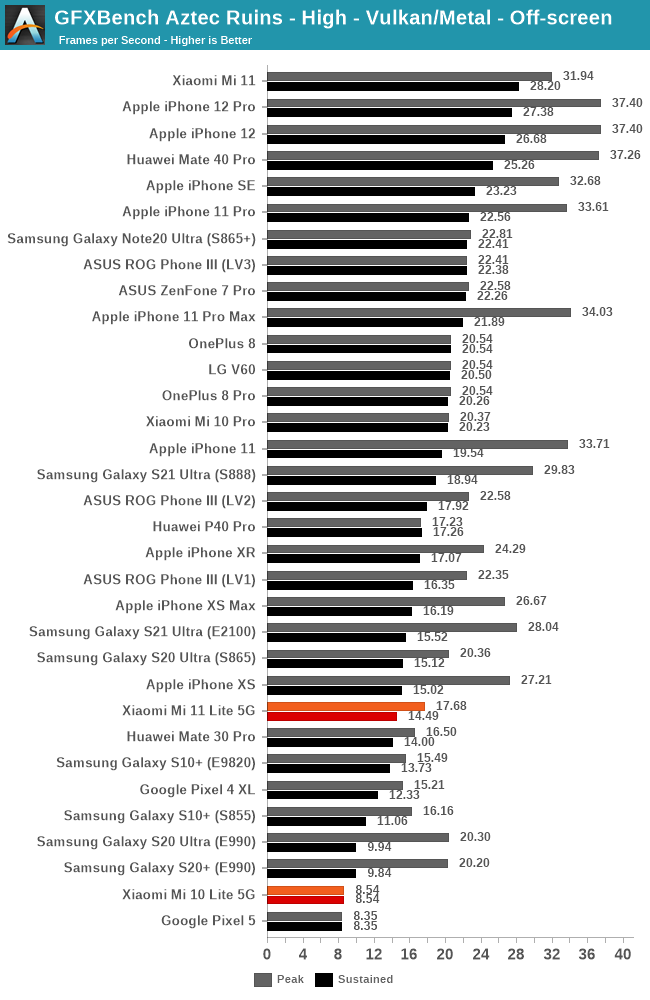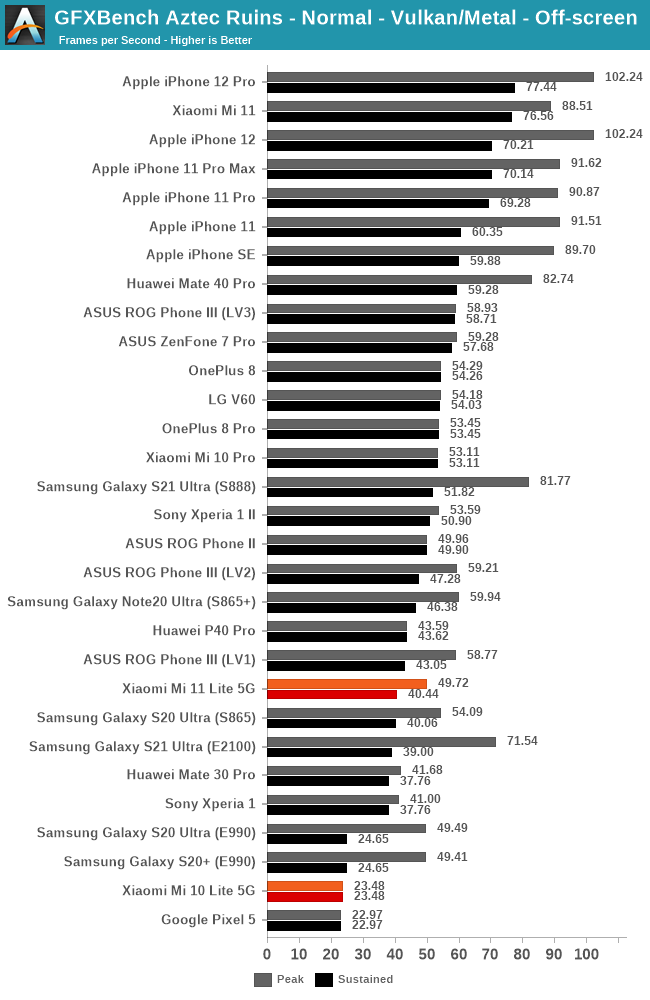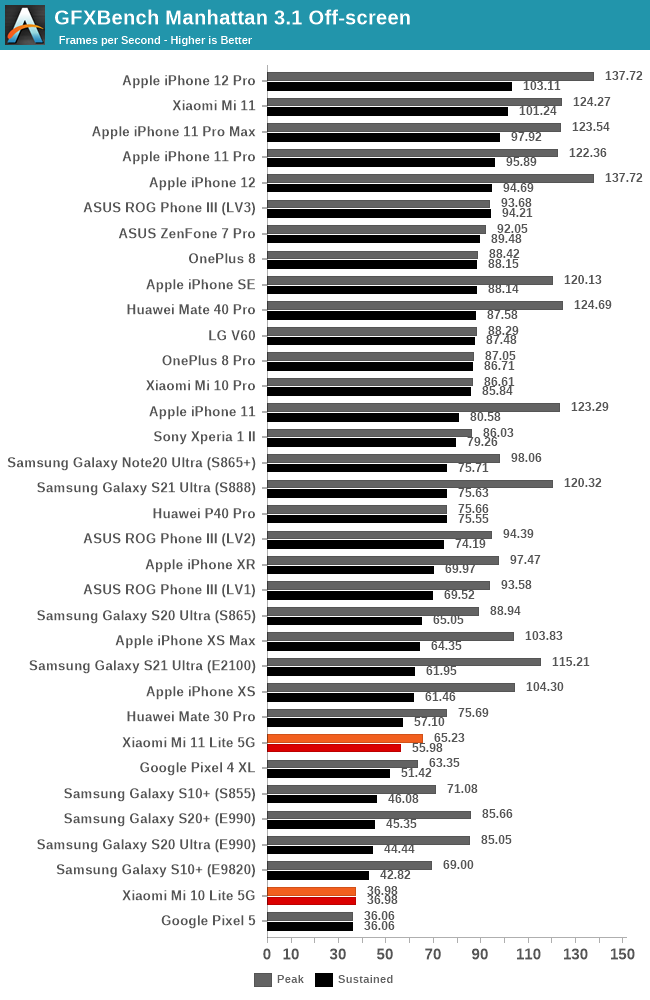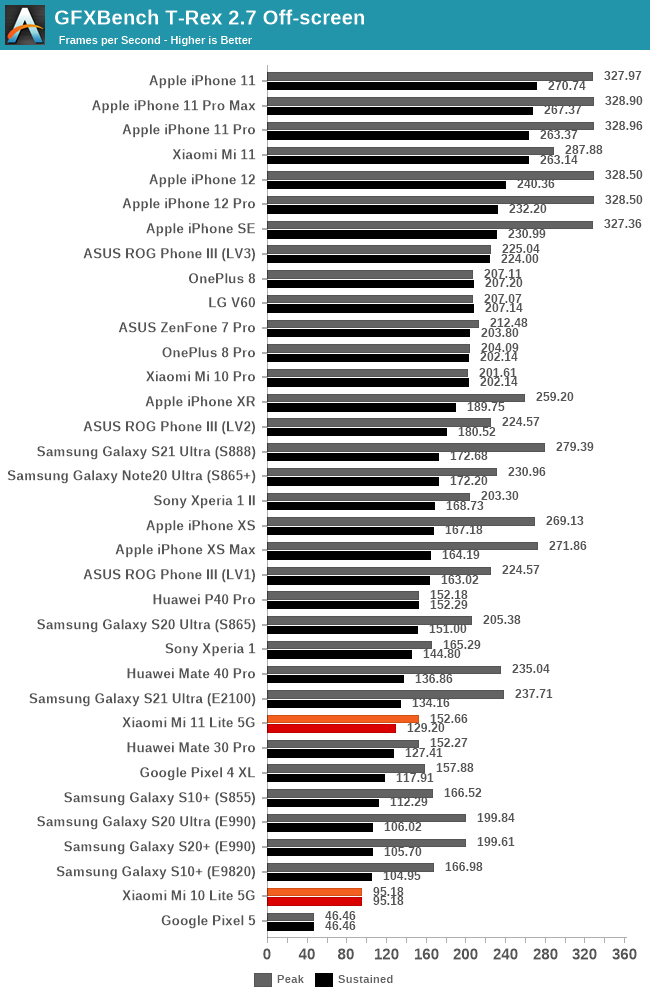Xiaomi Mi 11 Lite 5G Performance Report: First Taste of the Snapdragon 780G
by Andrei Frumusanu on April 13, 2021 9:00 AM ESTGPU Performance & Power
The GPU on the Snapdragon 780 is interesting – Qualcomm calls it an Adreno 642, and had promised performance increases over +50% compared to the Snapdragon 768G. This latter chip wasn’t employed as much, but it had promised +15% increases over the 765G. The combined math of the two generations should signify that the Snapdragon 780G should be around +72% faster than the Snapdragon 765G. It’s also interesting that Qualcomm called the GPU an Adreno 642 which is a larger numerical jump from the Adreno 620 of the previous generations – we asked ourselves how this would position itself against the Adreno 640 of the Snapdragon 855 flagship from a few years back.

Starting off with Basemark GPU, we’re off to a good start with peak performance increases of +50% versus the Xiaomi Mi 10 Lite 5G with the Snapdragon 765G.
As a note, these results also include updated performance numbers of the Pixel 5 which features the same S765G chipset; Google’s latest April patch seems to have finally (after 6 months….) resolved the crippling GPU performance behaviour which the device suffered from since launch.

In GFXBench Aztec high, the performance increases are much higher, with the Mi 11 Lite 5G showcasing a +107% performance boost versus its predecessor, which is quite astounding.
| GFXBench Aztec High Offscreen Power Efficiency (System Active Power) |
||||
| Mfc. Process | FPS | Avg. Power (W) |
Perf/W Efficiency |
|
| iPhone 12 Pro (A14) 🔥 Throttled | N5 | 28.36 | 3.91 | 7.24 |
| Mate 40 Pro (Kirin 9000) 🔋 Power-Save | N5 | 23.71 | 3.35 | 7.07 |
| iPhone 11 Pro (A13) 🔥 Throttled | N7P | 26.14 | 3.83 | 6.82 |
| Galaxy S21U (Snapdragon 888) 🔥 Throttled | 5LPE | 18.94 | 2.81 | 6.71 |
| iPhone 12 Pro (A14) ❄️ Peak | N5 | 37.40 | 5.57 | 6.64 |
| iPhone 11 Pro (A13) ❄️ Peak | N7P | 34.00 | 6.21 | 5.47 |
| Galaxy S20U (Snapdragon 865) | N7P | 20.35 | 3.91 | 5.19 |
| Mi 11 Lite 5G (Snapdragon 780G) | 5LPE | 17.68 | 3.46 | 5.10 |
| Mate 40 Pro (Kirin 9000) 🔥 Throttled | N5 | 27.37 | 5.39 | 5.07 |
| iPhone XS (A12) 🔥 Throttled | N7 | 19.32 | 3.81 | 5.07 |
| Reno3 5G (Dimensity 1000L) | N7 | 11.93 | 2.39 | 4.99 |
| Galaxy S21U (Exynos 2100) 🔥 Throttled | 5LPE | 18.55 | 3.73 | 4.96 |
| iPhone XS (A12) ❄️ Peak | N7 | 26.59 | 5.56 | 4.78 |
| Mi 10 Lite 5G (Snapdragon 765G) | 7LPP | 8.53 | 1.93 | 4.42 |
| Mate 40 Pro (Kirin 9000) ❄️ Peak | N5 | 37.22 | 8.53 | 4.36 |
| ROG Phone III (Snapdragon 865+) | N7P | 22.34 | 5.35 | 4.17 |
| Mate 30 Pro (Kirin 990 4G) | N7 | 16.50 | 3.96 | 4.16 |
| Galaxy S21U (Snapdragon 888) ❄️ Peak | 5LPE | 29.82 | 8.10 | 3.68 |
| Galaxy S21U (Exynos 2100) ❄️ Peak | 5LPE | 28.04 | 7.69 | 3.64 |
| Galaxy S20+ (Exynos 990) | 7LPP | 20.20 | 5.02 | 3.59 |
| Galaxy S10+ (Snapdragon 855) | N7 | 16.17 | 4.69 | 3.44 |
| Galaxy S10+ (Exynos 9820) | 8LPP | 15.59 | 4.80 | 3.24 |
Looking at power and power efficiency between the two generations, we’re seeing that the new chip roughly uses +80% power versus the S765G, and because the performance increase is larger than the power increase, there’s a perf/W increase in efficiency as well.

| GFXBench Aztec Normal Offscreen Power Efficiency (System Active Power) |
||||
| Mfc. Process | FPS | Avg. Power (W) |
Perf/W Efficiency |
|
| iPhone 12 Pro (A14) 🔥 Throttled | N5 | 77.44 | 3.88 | 19.95 |
| iPhone 12 Pro (A14) ❄️ Peak | N5 | 102.24 | 5.53 | 18.48 |
| iPhone 11 Pro (A13) 🔥 Throttled | N7P | 73.27 | 4.07 | 18.00 |
| Galaxy S21U (Snapdragon 888) 🔥 Throttled | 5LPE | 51.81 | 2.93 | 17.67 |
| Mate 40 Pro (Kirin 9000) 🔋 Power-Save | N5 | 53.49 | 3.10 | 17.25 |
| iPhone 11 Pro (A13) ❄️ Peak | N7P | 91.62 | 6.08 | 15.06 |
| iPhone XS (A12) 🔥 Throttled | N7 | 55.70 | 3.88 | 14.35 |
| Galaxy S20U (Snapdragon 865) | N7P | 54.09 | 3.91 | 13.75 |
| iPhone XS (A12) ❄️Peak | N7 | 76.00 | 5.59 | 13.59 |
| Reno3 5G (Dimensity 1000L) | N7 | 27.84 | 2.12 | 13.13 |
| Mi 11 Lite 5G (Snapdragon 780G) | 5LPE | 49.61 | 3.80 | 13.05 |
| Galaxy S21U (Exynos 2100) 🔥 Throttled | 5LPE | 46.29 | 3.85 | 12.02 |
| Mate 40 Pro (Kirin 9000) 🔥 Throttled | N5 | 63.56 | 5.37 | 11.84 |
| Mi 10 Lite 5G (Snapdragon 765G) | 7LPP | 23.48 | 2.07 | 11.70 |
| ROG Phone III (Snapdragon 865+) | N7P | 58.77 | 5.34 | 11.00 |
| Mate 40 Pro (Kirin 9000) ❄️ Peak | N5 | 82.74 | 7.95 | 10.40 |
| Mate 30 Pro (Kirin 990 4G) | N7 | 41.68 | 4.01 | 10.39 |
| Galaxy S20+ (Exynos 990) | 7LPP | 49.41 | 4.87 | 10.14 |
| Galaxy S10+ (Snapdragon 855) | N7 | 40.63 | 4.14 | 9.81 |
| Galaxy S21U (Snapdragon 888) ❄️ Peak | 5LPE | 81.77 | 8.40 | 9.73 |
| Galaxy S20U (Exynos 2100) ❄️ Peak | 5LPE | 71.53 | 8.10 | 8.83 |
| Galaxy S10+ (Exynos 9820) | 8LPP | 40.18 | 4.62 | 8.69 |
The figures in Aztec Normal showcase a similar story: Almost double the peak performance at roughly +80% power.
The generational comparisons here are interesting, and indeed the Adreno 642 of the Snapdragon 780 here lands ahead of the Adreno 640 of the Snapdragon 855, both in performance, as well as lower power, for a much higher efficiency. It’s actually comparable to the Snapdragon 865 from last year.

| GFXBench Manhattan 3.1 Offscreen Power Efficiency (System Active Power) |
||||
| Mfc. Process | FPS | Avg. Power (W) |
Perf/W Efficiency |
|
| iPhone 12 Pro (A14) 🔥 Throttled | N5 | 103.11 | 3.90 | 26.43 |
| Galaxy S21U (Snapdragon 888) 🔥 Throttled | 5LPE | 75.62 | 2.91 | 25.98 |
| iPhone 12 Pro (A14) ❄️ Peak | N5 | 137.72 | 5.63 | 24.46 |
| iPhone 11 Pro (A13) 🔥 Throttled | N7P | 100.58 | 4.21 | 23.89 |
| Mate 40 Pro (Kirin 9000) 🔋 Power-Save | N5 | 95.01 | 4.35 | 21.83 |
| Galaxy S20U (Snapdragon 865) | N7P | 88.93 | 4.20 | 21.15 |
| iPhone 11 Pro (A13) ❄️Peak | N7P | 123.54 | 6.04 | 20.45 |
| iPhone XS (A12) 🔥 Throttled | N7 | 76.51 | 3.79 | 20.18 |
| Reno3 5G (Dimensity 1000L) | N7 | 55.48 | 2.98 | 18.61 |
| Galaxy S21U (Exynos 2100) 🔥 Throttled | 5LPE | 72.66 | 4.04 | 17.98 |
| Mate 40 Pro (Kirin 9000) 🔥 Throttled | N5 | 87.31 | 4.98 | 17.54 |
| iPhone XS (A12) ❄️Peak | N7 | 103.83 | 5.98 | 17.36 |
| Mi 11 Lite 5G (Snapdragon 780G) | 5LPE | 65.57 | 3.78 | 17.34 |
| Mi 10 Lite 5G (Snapdragon 765G) | 7LPP | 36.98 | 2.61 | 17.28 |
| ROG Phone III (Snapdragon 865+) | N7P | 93.58 | 5.56 | 16.82 |
| Galaxy S20U (Exynos 2100) ❄️ Peak | 5LPE | 115.20 | 7.62 | 15.11 |
| Mate 40 Pro (Kirin 9000) ❄️Peak | N5 | 124.69 | 8.28 | 15.05 |
| Mate 30 Pro (Kirin 990 4G) | N7 | 75.69 | 5.04 | 15.01 |
| Galaxy S20+ (Exynos 990) | 7LPP | 85.66 | 5.90 | 14.51 |
| Galaxy S10+ (Snapdragon 855) | N7 | 70.67 | 4.88 | 14.46 |
| Galaxy S21U (Snapdragon 888) ❄️ Peak | 5LPE | 120.32 | 8.34 | 14.42 |
| Galaxy S10+ (Exynos 9820) | 8LPP | 68.87 | 5.10 | 13.48 |
| Galaxy S9+ (Snapdragon 845) | 10LPP | 61.16 | 5.01 | 11.99 |
| Mate 20 Pro (Kirin 980) | N7 | 54.54 | 4.57 | 11.93 |
| Galaxy S9 (Exynos 9810) | 10LPP | 46.04 | 4.08 | 11.28 |
| Galaxy S8 (Snapdragon 835) | 10LPE | 38.90 | 3.79 | 10.26 |
| Galaxy S8 (Exynos 8895) | 10LPE | 42.49 | 7.35 | 5.78 |
The Manhattan 3.1 figures are both equivalent in the performance and power increases at around +77% - with efficiency roughly staying flat because of that. It’s to be noted that this is still extremely impressive as usually performance increases of such a degree come with efficiency hits – however the new GPU and process node are doing their job to keep the efficiency high.

| GFXBench T-Rex Offscreen Power Efficiency (System Active Power) |
||||
| Mfc. Process | FPS | Avg. Power (W) |
Perf/W Efficiency |
|
| iPhone 12 Pro (A14) 🔥 Throttled | N5 | 260.28 | 4.08 | 63.97 |
| Galaxy S21U (Snapdragon 888) 🔥 Throttled | 5LPE | 172.67 | 2.70 | 63.74 |
| iPhone 11 Pro (A13) 🔥 Throttled | N7P | 289.03 | 4.78 | 60.46 |
| iPhone 12 Pro (A14) ❄️ Peak | N5 | 328.50 | 5.55 | 59.18 |
| iPhone 11 Pro (A13) ❄️ Peak | N7P | 328.90 | 5.93 | 55.46 |
| Galaxy S20U (Snapdragon 865) | N7P | 205.37 | 3.83 | 53.30 |
| Mate 40 Pro (Kirin 9000) 🔥 Throttled | N5 | 147.13 | 2.92 | 50.38 |
| iPhone XS (A12) 🔥 Throttled | N7 | 197.80 | 3.95 | 50.07 |
| Mate 40 Pro (Kirin 9000) 🔋 Power-Save | N5 | 201.85 | 4.10 | 49.22 |
| ROG Phone III (Snapdragon 865+) | N7P | 224.48 | 4.92 | 45.60 |
| Mi 10 Lite 5G (Snapdragon 765G) | 7LPP | 95.17 | 2.58 | 45.09 |
| Mi 11 Lite 5G (Snapdragon 780G) | 5LPE | 151.91 | 3.37 | 44.98 |
| iPhone XS (A12) ❄️Peak | N7 | 271.86 | 6.10 | 44.56 |
| Galaxy 10+ (Snapdragon 855) | N7 | 167.16 | 4.10 | 40.70 |
| Galaxy S21U (Exynos 2100) 🔥 Throttled | 5LPE | 153.28 | 3.80 | 40.30 |
| Reno3 5G (Dimensity 1000L) | N7 | 139.30 | 3.57 | 39.01 |
| Mate 40 Pro (Kirin 9000) ❄️ Peak | N5 | 235.04 | 6.11 | 38.46 |
| Galaxy S20+ (Exynos 990) | 7LPP | 199.61 | 5.63 | 35.45 |
| Mate 30 Pro (Kirin 990 4G) | N7 | 152.27 | 4.34 | 35.08 |
| Galaxy S21U (Snapdragon 888) ❄️ Peak | 5LPE | 279.39 | 7.98 | 35.01 |
| Galaxy S9+ (Snapdragon 845) | 10LPP | 150.40 | 4.42 | 34.00 |
| Galaxy 10+ (Exynos 9820) | 8LPP | 166.00 | 4.96 | 33.40 |
| Galaxy S9 (Exynos 9810) | 10LPP | 141.91 | 4.34 | 32.67 |
| Galaxy S8 (Snapdragon 835) | 10LPE | 108.20 | 3.45 | 31.31 |
| Galaxy S20U (Exynos 2100) ❄️ Peak | 5LPE | 237.71 | 8.02 | 29.61 |
| Mate 20 Pro (Kirin 980) | N7 | 135.75 | 4.64 | 29.25 |
| Galaxy S8 (Exynos 8895) | 10LPE | 121.00 | 5.86 | 20.65 |
Finally, in T-Rex, the performance has also gone up by +60%. This is a workload that we expect to be more fill-rate bound by now, but the fact that the new SoC is able to manage such a larger boost even though it retains the exact same LPDDR4X-2133 2x16b memory interface is again quite impressive – it’s actually faster and more efficient than the flagship Exynos 2100 when it has to throttle down after prolonged periods.
Extremely Large Performance Boosts
In general, the GPU of the Snapdragon 780 is extremely impressive due to the fact how large a boost it makes in comparison to the Snapdragon 765G last year. I admit, we were never really too convinced about the S765G performance as it really only matched quite old flagship SoCs such as the Snapdragon 835.
The new Snapdragon 780 essentially jumps a few generations, and you can essentially expect to outperform Snapdragon 855 flagships, falling short of the Snapdragon 865 devices of last year.
Qualcomm was able to achieve this through a big increase in the power usage of the GPU. The Snapdragon 765 was extremely conservative with tiny power envelopes of around 2-2.6W. The Snapdragon 780G now is falling around 3.5-3.8W. This is still perfectly reasonable and well within the power envelope capacity of most devices without throttling. On the Mi 11 Lite 5G I saw some minor throttling, but I’m not sure the device is all that thermally optimised given its thinner form-factor.










25 Comments
View All Comments
zentwo - Tuesday, April 13, 2021 - link
It has been suggested in some reviews that there is thermal throttling on the Mi 11 Lite 5G after around 5 minutes of benchmarking, while there is no throttling on the 4G version with the 732G. So it may be interesting to also test thermal throttling of this device.Andrei Frumusanu - Tuesday, April 13, 2021 - link
The sustained performance metrics in the GPU section are extended +30 minute throttling levels. There is a little bit of it but nothing substantial or problematic.Kangal - Wednesday, April 14, 2021 - link
Thanks Andrei for the review.I'm a bit surprised that Qualcomm released a chipset this fast and this efficient. Normally at this price point, I would've expected late 2022, as that's how slow Qualcomm's being with their mid-range chips. They must either be shifting strategy, being mindful of the competition, or something else.
The "something else" I feel like is ARMv9. There might be a divide coming, like there was during the 2014-2016 transition of 32bit and 64bit phones. It was particularly nasty from the software update path, when comparing Android 4.4 to 5.1
Any thoughts on that matter?
ZolaIII - Wednesday, April 14, 2021 - link
Midrange is 50% of all mobile SoC's sold and counts in for 70% of all mobile SoC's QC sells. Short answer is competition or better said higher tier of MTK Dimemsity SoC's. This way QC will stay at least one and a half steep ahead (better 5G and A78 core's).mekpro - Tuesday, April 13, 2021 - link
What is the cache size of this 780G ?Chaser - Tuesday, April 13, 2021 - link
Got to love progress. I am not a phone gamer. So a powerful midrange SoC like this one is very interesting.Linustechtips12#6900xt - Tuesday, April 13, 2021 - link
I love these new powerful midrange phones and chips, super power-efficient and I don't game or whatever besides some minor clash of clans or something like that stupid so it makes total sense to me rather than getting a phone with an sd888 and having worse battery life.KarlKastor - Tuesday, April 13, 2021 - link
@AndreiCan you say something to cache sizes and GPU clock?
Such data is available to the flag ship SoC, but never for the smaller ones.
Would be interesting for the 765, 750 and 730 too.
Wardrive86 - Tuesday, April 13, 2021 - link
I wonder if any of the GPU tests truly stress memory bandwidth. The Adreno 642(780G) outperforms the Adreno 640(855) in these benchmarks with half the memory bandwidth. As they are both Adreno 600 parts im assuming no new compression techniques are in use.iphonebestgamephone - Thursday, April 15, 2021 - link
Its only outperforming in the aztec normal test. I did some tests on my 855 device and got 44 and 17 fps on normal and high respectively. The sustained results are a matter of efficiency. Looks like the bandwidth doesnt matter much for benchea or games. 780g perfroms the same as 855 even in genshin impact.